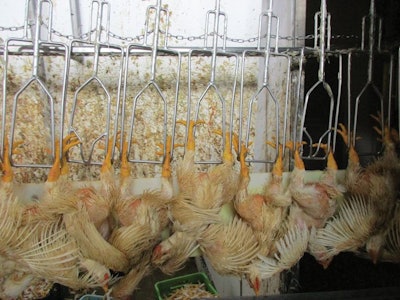
Ensuring high levels of human and bird welfare in poultry processing plants can help to raise yield and reduce the cost per kilo of meat produced. From harvesting through to chilling, there are a number of key points where particular attention needs to be paid to ensure that neither human nor bird welfare are compromised. Additionally, welfare monitoring needs to be response to changes in market demands.
The trend, in some markets, towards processing larger birds brings with it additional welfare issues for birds and plant workers alike. However, the problem is not without its solutions.
When crating birds for transport to the processing plant, typically crates big enough to hold birds ranging from small to what has traditionally been deemed large are used. However, the market has started to demand birds that average 3.5 kg and that can, in extreme cases, weight up to 4 kg.
To protect bird welfare plants may have to have two crate sizes to accommodate varying broiler sizes.
Adjustable height crates, if available, would solve this problem, reducing processors’ inventory costs and requiring a smaller storage area.
An alternative, however, with additional animal welfare benefits would be to rear broilers in crates from the day they arrive on farm, dispatching them to slaughter in the same crates. This would reduce any harm that may come to them during harvest and transport. Crates would simply be lifted by forklift onto trailers at the farm and unloaded at the processing plant.
At the processing plant
While broilers are at the processing plant and waiting to be hung on the shackles at the processing plant they may overheat and die. Monitoring by camera can help facilitate necessary intervention should birds show signs of overheating through panting.
In hot climates, the number of dead on arrival birds should not exceed 0.1% of the total number of birds processed each day. Good environmental management in the reception area could reduce this figure to 0.05%.
Hanging on the shackles
Hanging larger birds on the overhead shackles may compromise worker welfare. The weight of bigger broilers requires workers to exert themselves more and this may affect their performance.
To address this problem, a solution may be the installation of special supports or rocker arms, similar to those used with neck or vent cutters, allowing works to guide, rather than lift, broilers to the shackles.
Workers, with special bracelets that connect to these rockers would simply take the bird from the carousel or conveyor belt and guide it to the shackles, the rocker arm would support the broiler’s weight.
Route to the stunner entrance
Use of cameras along the route from the hanging area to the stunner entrance would allow bird distress to be monitored. If birds are stressed, corrective action should be taken immediately to prevent damage to the wings or breast. Stressed birds may flap their wings intensely resulting in wing damage and bruising, along with damage to the thorax bones and consequent bleeding. Should this occur, carcass quality will be compromised.
Stunning
A camera can also be installed at the stun bath entrance to monitor whether birds suffer pre-shock. Pre-shock can cause broilers to writhe in the shackles and to intensely flap their wings. In addition to wing damage, this may also lead to humerus dislocation and bleeds around where the humerus meets the clavicle.
Depending on the extent of any damage, quality control inspectors may either fully, or partially, condemn that part of the carcass.
Bleed tunnel
If birds have been properly stunned, and there are no feed withdrawal issues, they should remain calm during transit through the bleed tunnel. However, a number of factors may prevent passage through the bleed tunnel occurring as it should.
Preshock may cause birds to remain conscious, and this will be apparent due to writhing and intense wing flapping. Should the neck cut not have been properly made, birds will experience a sensation of suffocation and flap their wings. Should bleed time be too short, birds may enter the scalder alive and die by drowning.
Cameras placed in the bleed tunnel can help to in monitoring that birds are properly bled.
Evisceration
When workers remove the intestinal package from broilers they typically have to hold the broiler carcass in one hand and work with the other. Heavier birds make this task more difficult and stressful. This stress could be reduced by supporting birds on a moveable metal horizontal structure resulting in workers having to exert themselves less.

Investing in staff welfare and safety not only helps to protect workers but helps to ensure that plants are productive. | Courtesy Tyson Foods
Re-hanging on the overhead conveyor
When birds are re-hung on the conveyor, support arms can also be used so that workers do not have to support the birds’ weight but simply guide them to the shackles.
At the chiller
When carcasses come out of the chiller workers typically take them with both hands and lift then onto the shackles. Should large birds be processed, workers will tire more quickly. Bracelets and support arms at this stage of operations would also help to minimize worker exertion.
There are various points along processing operations where either human or animal welfare may be compromised. However, through monitoring, and remedial action where necessary, welfare can be protected while yields are maximized and costs per kilo of meat are reduced.















